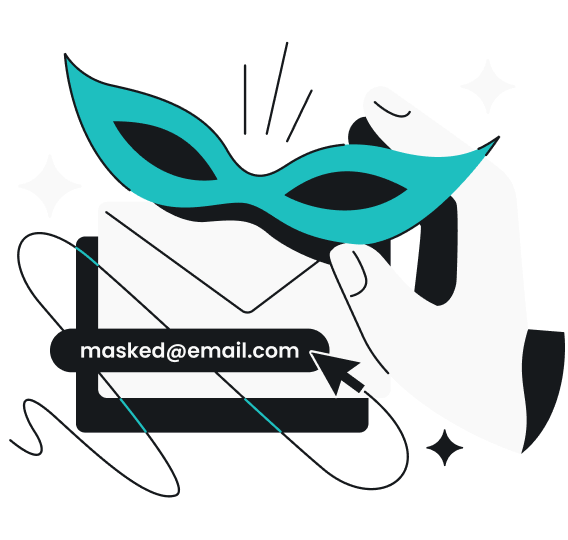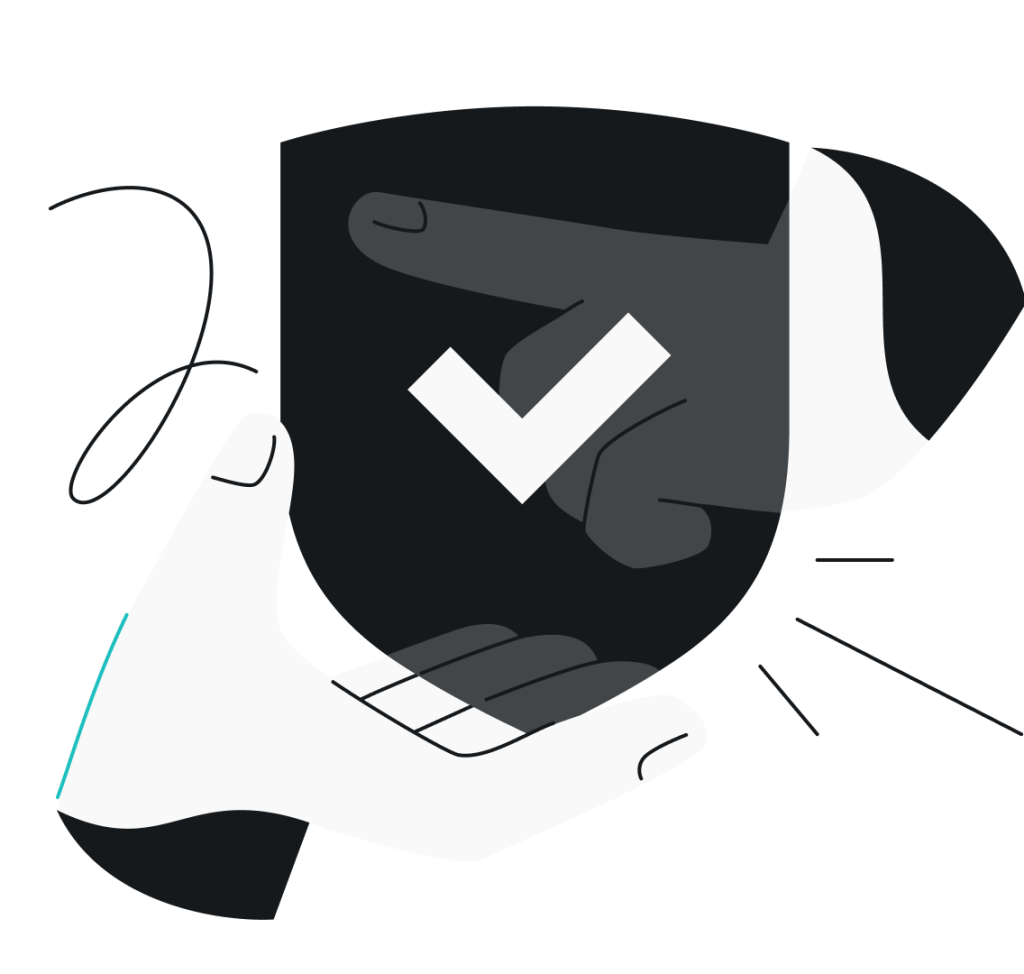Your email address is central to your digital identity, serving as the key to your online accounts and services. However, sharing it widely creates risk — every website that has your email becomes a potential source of spam, tracking, or data leaks. Email masking solves this by letting you create secure, disposable email aliases that protect your primary address while keeping you connected to online services.
What is email masking?
Email masking is a cybersecurity practice that involves creating alternate email addresses or aliases to protect the primary email account.
Email masking is particularly valuable when subscribing to newsletters, shopping online, or participating in forums since using your primary email address in these contexts could expose you to spam, unwanted marketing, phishing attempts, and data leaks.
How does email masking work?
Email masking creates a protective shield around your primary email address by generating alternate addresses that act as intermediaries between you and online services. Think of it as having a secure digital forwarding service — your masked email handles the initial contact while keeping your actual address hidden from view. Here’s how it works:
- Email forwarding: you can set up your masked email service to automatically forward messages to your real email address. This ensures seamless communication without exposing your primary inbox;
- Two-way communication: most email masking solutions allow you to reply to emails through the masked address. This ensures your identity stays private while maintaining the flow of conversation;
- Easy management: masked email services often provide management tools to enable, disable, or delete aliases. This is handy for organizing communications or terminating unwanted interactions;
- Integration with services: advanced tools, such as Surfshark’s Alternative ID, integrate seamlessly into your online life. They allow you to generate and manage masked emails on demand for specific purposes like subscribing to a newsletter or creating a new account.
7 benefits of email masking
Email masking offers a host of benefits, from enhanced privacy to streamlined communication. Let’s explore them in detail:
1. Privacy protection
Using a masked email protects your primary email address from being shared or sold by third parties, providing effective protection against data misuse.
2. Identity protection
A masked email protects your identity by decoupling the email address you share from your personal information. This makes it harder for someone to trace your online activities back to you, mitigating risks such as doxxing and profiling.
3. Anonymity
Maintaining anonymity can be crucial when engaging in online interactions such as forum discussions, shopping, or signing up for services. A masked email allows you to interact freely without revealing your personal information, ensuring your identity remains private and protecting you from email tracing and unwanted attention.
4. Reduced spam
Masked emails reduce the likelihood of your primary inbox becoming a dumping ground for spam. If a masked email starts attracting spam, you can simply disable or delete it without impacting your primary email.
5. Security
Masked emails act as a safeguard against phishing attacks and data leaks. Even if a website where you’ve used a masked email gets hacked, your primary email address — and any sensitive data associated with it — remains safe.
6. Reduced clutter
Email masking makes managing multiple projects, subscriptions, or services significantly easier. You can create multiple email addresses for different purposes: one for work, one for shopping, and another for newsletters. This helps with clutter and lets you easily identify and delete problematic addresses when needed.
7. Enhanced digital hygiene
Since you minimize the exposure of your primary email to countless databases and online forms, using a masked email helps maintain better online hygiene and reduces your overall digital footprint.
When should you use a masked email?
Using a masked email isn’t always necessary, but there are specific scenarios where it can make a significant difference. Here’s when you should — and shouldn’t — opt for a masked email.
Using a masked email is the right choice:
- When signing up for online services: to register for websites or apps that may send promotional emails or sell your data to third parties;
- When shopping online: to protect your primary inbox from spam, especially during seasonal sales or one-time purchases;
- When joining forums and online communities: to safeguard your anonymity in forums, discussion boards, or social media platforms where sharing personal details might be dangerous;
- When testing new services: if you’re uncertain about the reliability or security of a new online service;
- To avoid targeted ads: to prevent email tracking or personalized ads when downloading eBooks, subscribing to newsletters, or engaging in online surveys;
- To manage subscriptions: to efficiently organize and control your inbox if you subscribe to multiple newsletters or services.
Using a masked email is not recommended:
- For professional or official correspondence: to maintain credibility in job applications, business communications, or official documents;
- On trusted platforms: if you’re interacting with a platform you fully trust and need long-term, uninterrupted access to (e.g., banking, educational institutions);
- When regulations require real information: for compliance reasons, since some services, such as government or legal sites, may require verification through your primary email.
Note: If you suspect your government or network admin is blocking access to your email accounts, a VPN can help.
Why Surfshark’s Alternative ID is a great choice
Surfshark’s Alternative ID is a product designed to make email masking effortless, secure, and versatile. Here’s why it stands out from the crowd:
- Privacy-focused design: Surfshark’s Alternative ID prioritizes your privacy by allowing you to generate masked email addresses that can be linked to your primary email. This protects your actual email from being exposed to spam, phishing attempts, or data leaks;
- Seamless integration: Alternative ID integrates seamlessly into your online life, letting you generate masked emails directly when signing up for new services or platforms. It eliminates the need for complicated setups or multiple apps;
- Centralized management: Surfshark’s user-friendly interface lets you easily manage your masked emails. Enable, disable, or delete aliases with just a few clicks, ensuring you stay in control of your communications at all times;
- Enhanced security: by using a unique masked email for each service, you limit the damage in case of a potential data leak. Even if a service’s database is compromised, your primary email and personal information remain secure;
- Convenience and accessibility: Surfshark’s Alternative ID is designed for ease of use. You don’t need advanced technical skills to set it up, and it’s accessible across devices, making it perfect for everyday users;
- Added value with a VPN: Alternative ID comes bundled with Surfshark VPN, with additional features available in the One or One+ plans, providing a comprehensive privacy solution. With this, you can rest assured that Surfshark not only safeguards your primary email but also secures your online traffic.
How to set up Alternative ID
We’ve designed Alternative ID with intuitiveness in mind, and that philosophy extends to the setup process. Follow these steps to start protecting your personal data, including your email address, with ease:
Step 1: Log in to your Surfshark account
Begin by logging in to your Surfshark account on the website or the app. If you don’t have an account yet, you can sign up for a Surfshark subscription.
Step 2: Access Alternative ID
Navigate to the Alternative ID section in your Surfshark dashboard. You can find it in the left sidebar.
Step 3: Generate a masked email
Click the option to create a new masked email. You can customize the alias to suit your needs (e.g., for a specific website or service) or let Surfshark generate a random address for maximum anonymity.
Step 4: Link your primary email
Input your primary email address, where all forwarded messages from the masked email will be delivered. This ensures you receive communications without exposing your actual inbox.
Step 5: Manage your masked emails
Once created, your masked email appears in the management interface. From here, you can:
- Enable or disable forwarding;
- Edit or delete the alias if it’s no longer needed;
- Organize and label aliases for easy tracking.
Step 6: Start using your masked email
Use the newly generated masked email to sign up for services, newsletters, or any platform requiring an email address. All communications will be routed through this alias, keeping your primary email private.
Bonus: Monitor and adjust
Periodically review your masked emails to ensure they’re functioning as intended. Surfshark makes it easy to adjust settings or deactivate aliases that are no longer needed.
Different ways to mask your email
Email masking can be achieved through various methods, each offering unique advantages depending on your needs. Let’s explore the most common options:
Creating a fake email account
One straightforward way to mask your email is to create a secondary email account using a free service like Gmail or Yahoo. This account is separate from your primary one and can be used for specific purposes, such as signing up for newsletters or online shopping.
| Pros | Cons |
|---|---|
| Easy to set up and use | Requires regular monitoring and management |
| No need for additional tools or subscriptions | May still expose your identity if used frequently for the same purpose |
| Full control over the account |
Creating a temporary email account
Temporary email services like Temp Mail or Guerrilla Mail allow you to generate a free anonymous email account for short-term use. These accounts self-destruct after a specified time, making them ideal for one-off purposes.
| Pros | Cons |
|---|---|
| Instant setup with no personal information required | Emails are typically not saved long-term |
| Effective for single-use purposes like verification emails | Not suitable for ongoing interactions or subscriptions |
| Eliminates long-term spam concerns |
Creating an email alias
An email alias is a secondary address linked to your primary email. Services like Gmail, Outlook, or Surfshark’s Alternative ID allow you to create aliases for different purposes while keeping your primary email hidden.
| Pros | Cons |
|---|---|
| Easy to manage and integrate with your main email account | Requires support from your email provider |
| Allows two-way communication while maintaining privacy | May still expose your primary email if mismanaged |
| Multiple aliases can be created for different use cases |
Using an email masking service
Dedicated email masking services like Surfshark’s Alternative ID are specifically designed for privacy and security. These services generate unique, masked email addresses that forward messages to your real email.
| Pros | Cons |
|---|---|
| High level of privacy and security | May require a subscription or additional cost |
| Simple management tools for aliases | Dependent on the service provider’s reliability |
| Reliable and professional-grade protection against spam and phishing |
Masked emails vs. email aliases: what’s the difference?
Masked emails are alternate, usually temporary, addresses that enhance anonymity by keeping online interactions separate and secure. Services like Surfshark’s Alternative ID generate, manage, and delete these alternate addresses as needed — perfect for one-time signups or private online activities.
Email aliases serve a different purpose. These link to your main account, acting as organized channels for specific areas of your life, whether professional correspondence, subscription management, or personal communications. While aliases excel at streamlining your inbox, masked emails offer superior privacy protection by creating a genuinely separate barrier between you and potential online threats.
Take control of your email privacy today
The choice between privacy and convenience shouldn’t be a compromise. Email masking elegantly solves any dilemmas you might have on that front, offering both. Start using a masked email today and experience the confidence of truly secure online interactions.
FAQ
Can I mask my email address in Gmail?
Gmail allows you to create aliases by adding a + sign followed by custom text to your email address (e.g., yourname+alias@gmail.com). While this doesn’t fully mask your actual address, it helps you filter emails and track where your address is being used.
Can I mask my email in Outlook?
Yes, Outlook supports creating aliases linked to your primary email account. These aliases can be used for sending and receiving emails anonymously without exposing your primary address, providing an extra layer of privacy.
Can an email address be masked for free?
Yes, you can mask an email address for free by creating a Gmail alias or a temporary email account through a service like Temp Mail. However, for advanced features like email forwarding or centralized alias management, paid services like Surfshark’s Alternative ID are a better choice, offering enhanced security and convenience.



